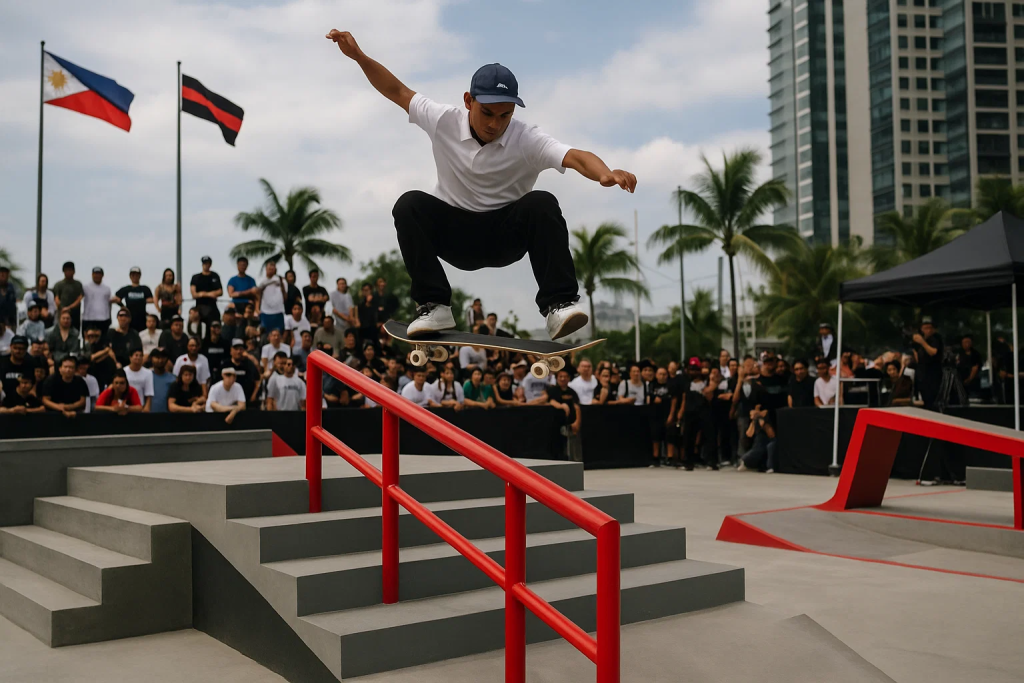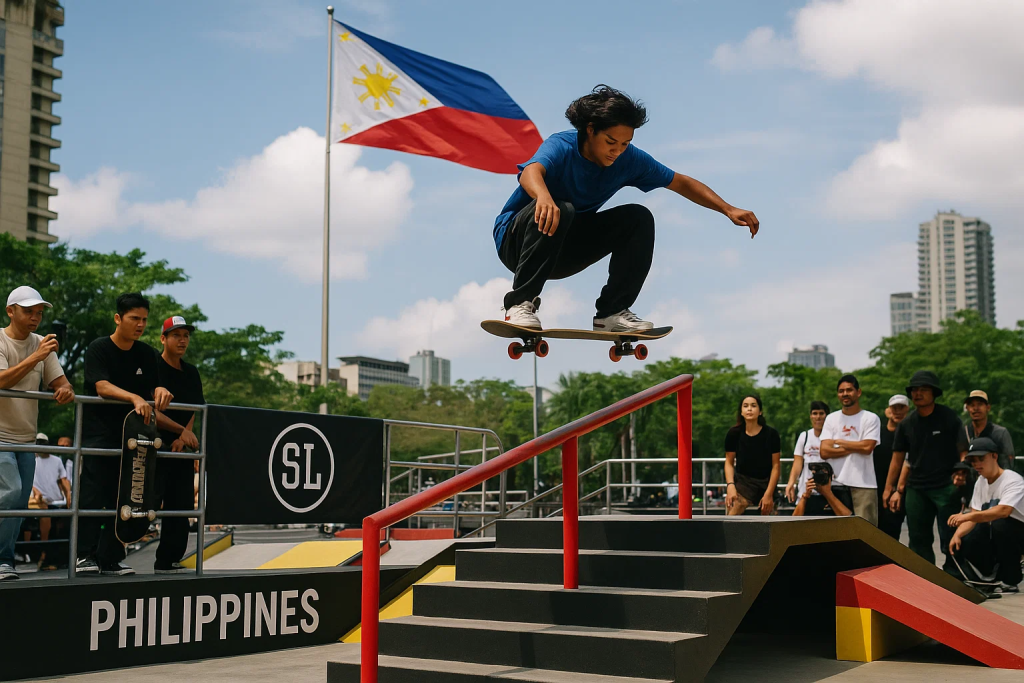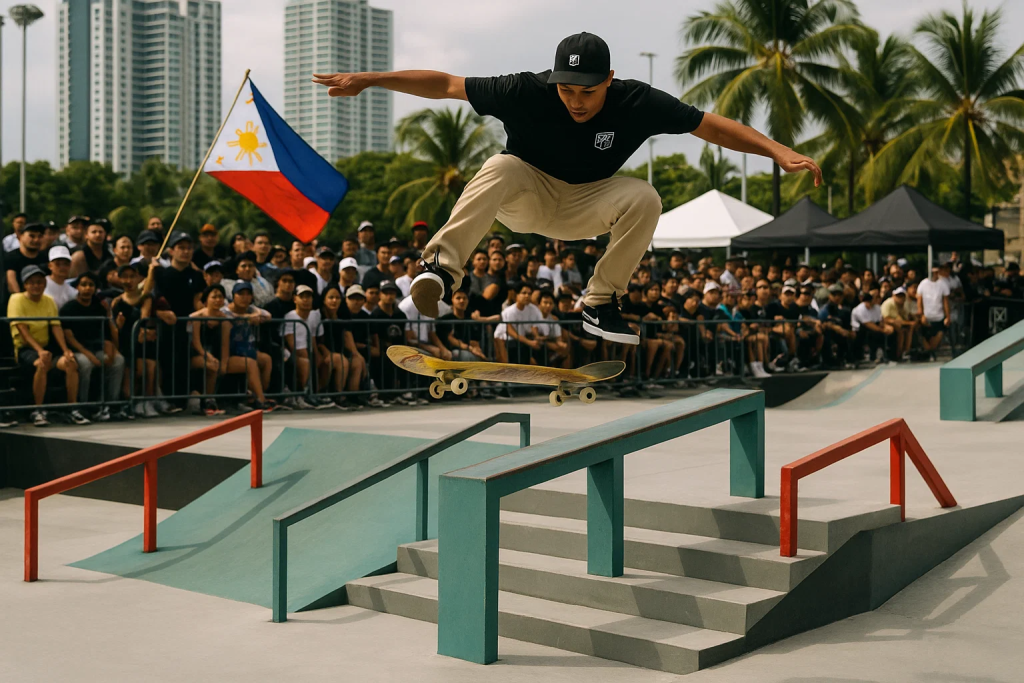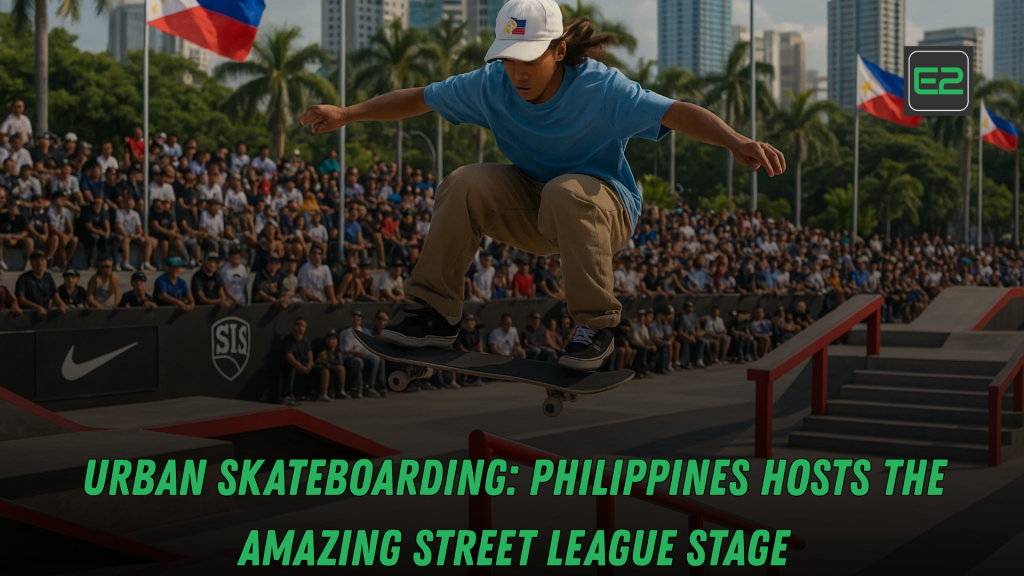Table of Contents
Quick take (TL;DR)
Momentum in the Philippines is real: Margielyn Didal—the country’s street icon—returned to SLS with a bronze in Santa Monica (May 2025), reigniting local calls for world-class facilities and events. Metro Manila now boasts GOMO/Mountain Dew Skate Park @ Circuit Makati and a thriving city-street scene (BGC and other urban spots), while Cebu continues to push for a public skatepark to complement Didal’s private training facility in Soul Sierra.
Street League Skateboarding (SLS) is the world’s premier pro street series, staged on custom-built courses inside arenas and iconic city “spot takeovers.” In 2025, SLS announced three Arena Stops + four Spot Takeovers (e.g., Paris) but no Philippines stop is on the published slate as of now.
This guide explains what it would take for Manila (or Cebu) to credibly host a future SLS stage: venues, logistics, course build, sponsorship, broadcast, fan experience, community legacy, and policy/permissions—plus a ready-to-use hosting checklist, sample fan itineraries, and FAQs.
Status check (as of September 3, 2025): No SLS–Philippines stop is officially listed. This article is a playbook and preview for how the country can position itself to win a bid and deliver a world-class stop when the timing aligns.

Why the Philippines is ready for the big stage
1) A star that moves the needle: Margielyn Didal
From Asian Games gold to the Olympics and a 2025 SLS podium, Didal has repeatedly put PH skateboarding on the global map. Her Santa Monica bronze became a local rallying point to finally deliver on long-promised public facilities—especially in Cebu.
- SLS relevance: A home SLS stop energizes a nation when there’s a compelling home favorite. Didal is that anchor—especially for women’s street.
- Facility narrative: Cebu’s public-park push remains in the headlines; a future SLS activation could catalyze funding and timelines.
- Training base: Didal trains at a private Soul Sierra park in Cebu, designed with high-performance inputs—proof the athlete pipeline can thrive with proper spaces.
2) A capital in the Philippines that understands arenas, broadcast, and tourism
Manila routinely hosts major sports and music tours. SLS requires arena control for its unique course build and lighting/broadcast needs, plus the ability to run “spot takeover” showcases in photogenic urban spaces.
- Arena logic: SLS courses are purpose-built inside venues; Manila’s large indoor arenas (e.g., near MOA complex/Araneta corridors) are accustomed to stage-in/stage-out builds.
- City visuals: Beyond the arena, the metropolis has striking urban canvases (harborside skylines, BGC avenues, heritage districts) ideal for spot-takeover content—the kind SLS has leaned into globally.
- Fan travel: International access is straightforward via NAIA, with wide hotel stock near likely venues.
3) A Philippines street scene with growing infrastructure
Manila’s GOMO/Mountain Dew Skate Park @ Circuit Makati is a high-visibility hub; the broader Metro area enjoys an increasingly skate-curious public realm, including BGC’s promenades and mixed-use plazas utilized by skaters. While not all public spaces are official skateparks, the urban fabric has become more skate-tolerant and photogenic for content. Cebu, meanwhile, is pushing to convert momentum into true public facilities, a key legacy pillar for any major event.
SLS 101: How the tour works—and why it matters
Street League Skateboarding (SLS) is the world’s premier pro street series. Events use custom-built, one-of-a-kind courses engineered for progressive tricks, live scoring, broadcast storytelling, and elite athlete safety.
For 2025, SLS confirmed a global slate built around three arena stops and four spot takeovers; Paris was among the highlighted dates. The format leans into elite competition plus cinematic city integrations for digital reach.
Sponsorship trend: In August 2025, SLS unveiled a global partnership with Stake, signaling bigger integrated activations, fan tech, and cross-market engagement as the tour travels worldwide.
Implication for Manila: To host, you must deliver arena quality, city cooperation, brand activation zones, and content-worthy backdrops—all at a standard SLS can take global.
The Manila (or Cebu) in Philippines Hosting Playbook
Below is an end-to-end plan to pitch, win, and run an SLS-caliber event—customizable for Manila (Arena + City Takeover) or Cebu (Heritage + Waterfront narrative).
A) The bid narrative
- Athlete storyline: “Home of Margielyn Didal” + a rising youth base (e.g., Go Skateboarding Day turnouts). This converts to guaranteed media angles and attendance enthusiasm.
- City promise: “Two-chapter weekend”—Arena Final + Spot Takeover (iconic Manila angles or Cebu waterfront/hill vista).
- Legacy pledge: Permanent upgrades—e.g., refurb of Circuit Makati features and creation/upgrade of public park in Cebu as a visibility exchange; publish timelines.
- Sponsorship ecosystem: Blend global tour partners (e.g., Stake) with local telco/retail/QSR to localize promotions and community programs.
B) Philippines Venue & city selection
- Arena requirements: 10–15k capacity sweet spot, ceiling height for camera cranes, course footprint (typically a basketball floor + staging), broadcast docks, load-in efficiency, and 24/7 security per build schedule. (Framework based on SLS arena builds.)
- Spot takeover sites (permitting): Harborside promenade, civic plaza, or BGC-style boulevard that balances photogenic lines, safe spectator zones, and minimal traffic disruption.
- Practice & qualifiers: Utilize Circuit Makati for media day and community clinics; consider Cebu satellite qualifiers to broaden participation.
C) Course build & safety
- Specs: International-grade concrete/wood features, fresh grip, pro rail/ledge geometry; progressive but safe gaps for women’s and men’s runs. (SLS is known for bespoke builds.)
- Schedule: 7–10 day load-in/build, 2–3 day comp block, 2–3 day load-out; night shifts to hit deadlines.
- Weather plan: Indoor finals reduce risk. Outdoor takeovers require rain contingency, slick-surface protocols, and drying rigs.
D) Permits, compliance & community
- City hall & traffic management: Road closures and foot traffic plans, emergency egress, and public advisories.
- Public safety: Medical on site, hydration stations, shade structures, heat mitigation plan.
- Community relations: Clear signage on where you can/can’t skate; keep local residents and businesses in the loop.
- Youth inclusion: Free clinics with national team skaters; scholarship slots for girls’ and adaptive skating.
E) Sponsorship & fan economy of the Philippines
- Global x Local: Merge SLS tour partners (e.g., Stake) with PH telco, streetwear, sneakers, beverage, payments, convenience retail. Build QR quests, fan voting, and UGC challenges.
- Merch village: Capsule collabs with local artists; screen-printing booths; board art showcases.
- Food & night program: Street food lanes + music showcases = full-day destination.
F) Broadcast & content engine
- Cameras: Rail cams + jibs + handhelds for trick isolation; mic’d commentary positions with event “soundscape.”
- Storylines: Follow Didal (PH hero), rising Asian talents, and global headliners. Leverage SLS’s live scoring drama and “best trick” arcs for short-form content.
- Local creators: Pair global feeds with PH skate creators for reels/TikTok; daily trick recaps and “fan fit checks.”
G) Ticketing & access
- Tiers: Grounds (affordable youth tier), lower bowl (prime angles), VIP lounge (hospitality with athlete Q&A).
- Bundles: “Weekend combo” (Arena + Takeover), plus “Clinic add-on” for kids.
- Equity: Student pricing, NGO partners for community passes.

What success looks like (KPIs)
- Attendance: 85–95% arena sell-through; 20–40k for outdoor takeover footfall.
- Digital: 30–50M social impressions, 10–15M video views across platforms.
- Media value: International skate outlets + PH mainstream sports/entertainment.
- Legacy: Public-park deliverables: resurfacing, new ledge/rail lines, lights, and maintenance funding.
- Participation: 1,000+ clinic slots for kids/girls/adaptive, with measurable follow-on sign-ups at local parks.
Philippines Fan guide: If/when SLS lands in Manila
How to plan the weekend
- Day 0 (Thu PM): Arrive, shakeout session at Circuit Makati; hit the merch village soft-open.
- Day 1 (Fri): Qualifiers + practice. Evening: local film night or live bands.
- Day 2 (Sat): Semis + Best Trick; after-hours: street photo walk at BGC.
- Day 3 (Sun): Finals + medal ceremony; cap with city takeover demo and open jam.
Where to skate (responsibly)
- Circuit Makati (GOMO/Mountain Dew park): The official community anchor. Respect sessions and park etiquette.
- Urban spots: Many are shared public spaces—watch for security rules and pedestrians; keep it chill.
What to pack
- Board + backup hardware, Allen keys, bearings, fresh shoelaces, hydration, microfiber towel, sunblock. For night sessions, a portable light and reflective accents.
Why a Philippines stop benefits SLS (and vice versa)
- Regional reach: Southeast Asia’s massive youth demo + social media intensity = outsized digital returns.
- Women’s street growth: Featuring Didal and the region’s next wave accelerates girls’ participation.
- Course creativity: Manila’s arena design + outdoor takeovers offer aesthetic diversity for the SLS highlight reel.
- Commercial expansion: New sponsors (telco/fintech/QSR) that play well in Asia can scale across the tour.
Reality check: What’s still missing?
- Facilities gap: Outside of Circuit Makati and a small set of Metro parks/DIYs, public skate infrastructure needs scale and maintenance. Cebu’s public park remains in limbo.
- Policy clarity: Consistent, skate-friendly city guidelines reduce friction between skaters and security.
- Funding consistency: Legacy projects should be budget-protected, not one-off PR builds.
Action plan for stakeholders
City & tourism boards
- Publish a Skate City Charter (permitting playbook, public-space guidelines, maintenance cycle).
- Commit to two-park upgrades (Metro Manila + Cebu), with posted timelines and budgets.
- Provide in-kind: traffic marshals, EMTs, park utilities.
Brands
- Adopt “Sponsor a Feature”: name a rail/ledge set and fund its maintenance for 3–5 years.
- Power youth clinics and scholarships for girls/adaptive programs.
Skate orgs & schools
- Create a school circuit (safe beginner divisions) feeding into community nights at city parks.
- Train local marshals/coaches; certify first-aid and concussion protocols.
Media & creators
- Balance trick porn with human stories: beginner journeys, parent guides, women’s sessions, adaptive breakthroughs.
Sample hosting checklist (print-friendly)
Pre-bid (T-12 to T-9 months)
- Draft bid letter; identify arena & takeover sites; initial brand coalition
- Community/legacy plan (Circuit upgrade + Cebu public park milestone)
- Preliminary budget, broadcast partner, and logistics map
Course & ops (T-8 to T-4 months)
- Confirm build vendor; finalize geometry; safety & weather plans
- Permits: road closure, noise, sanitation, EMT/PPE, insurance
- Volunteer recruitment; venue wayfinding; ticket tiers
Comms (T-6 to T-0 months)
- 12-week content calendar (athlete spotlights, “how to attend,” clinic sign-ups)
- PR with Didal + regional headliners; UGC trick challenges
- Publish Legacy Tracker page with construction updates
Event week
- Daily ops brief; hydration and heat index checks
- Social: live scoring clips, best-trick slow-mos, fan-fit features
- Issue post-event KPI report and legacy follow-through dates

Strong call-to-action (CTA)
City leaders, brands, and the skate community: if you want an SLS-caliber weekend in Manila (and a lasting legacy in Cebu), organize now. Start with:
- Form a Manila x Cebu Skate Task Force (city hall + NSA + community captains).
- Fund two deliverables: a) Circuit Makati feature upgrades, b) Cebu public park with published timeline.
- Pitch SLS with a two-chapter weekend (Arena Final + Spot Takeover) and a measurable legacy.
When the groundwork is real, the world takes notice—and the highlight reel takes care of itself.
Frequently Asked Questions (FAQ)
1) Is a Street League stop in the Philippines officially confirmed?
2) What makes the Philippines a credible host?
3) Which local parks or hubs can support event week?
4) What does SLS require that’s different from a typical contest?
Sources
- SLS About & 2025 Season (format, custom builds, schedule highlights).
- SLS x Stake partnership (Aug 2025).
- Margielyn Didal SLS podium (May 2025) & Cebu skatepark discussions.
- PH skate hubs: GOMO/Mountain Dew Skate Park (Circuit Makati) & community references.
Note: Event calendars, sponsor slates, and city policies change. Always confirm the latest schedule and requirements.
The article is a strategic playbook arguing that the Philippines—particularly Manila (with a Cebu legacy tie-in)—is well positioned to host a future Street League Skateboarding (SLS) stage, even though no PH stop is currently confirmed on the 2025 slate. It explains what SLS is (the premier pro street series with custom arena builds and city spot takeovers) and details the operational, commercial, and community ingredients needed to win and deliver a world-class stop.
Why PH is ready: The country has a compelling anchor in Margielyn Didal, whose 2025 SLS podium reignited momentum for world-class facilities and a strong women’s street narrative. Metro Manila offers arena experience, broadcast know-how, tourism infrastructure, and photogenic urban canvases for spot-takeover content. The GOMO/Mountain Dew Skate Park @ Circuit Makati serves as a visible hub, while Cebu can convert hype into a public skatepark—a meaningful legacy.
Hosting playbook:
- Bid narrative: Leverage Didal’s storyline, propose a two-chapter weekend (Arena Final + city Spot Takeover), and pledge a tangible legacy (Circuit upgrades + Cebu public park).
- Venues: A 10–15k indoor arena with load-in efficiency, ceiling height for camera cranes, and secure build windows; outdoor sites that balance visuals and safety.
- Course & safety: Bespoke rails/ledges/gaps, 7–10 day build, weather contingencies, medical/hydration/heat plans.
- Permits & community: Road closure, traffic, emergency egress, neighborhood comms, and youth clinics (girls/adaptive).
- Sponsorship & fan economy: Blend global SLS partners with local telco, sneaker, beverage, and retail brands; add merch villages, artist collabs, and QR-driven fan quests.
- Broadcast & content: Multi-camera rails/jibs, live scoring drama, “best trick” arcs, and collabs with PH skate creators.
- Ticketing: Youth-friendly grounds passes, bowl seats, VIP hospitality, weekend bundles, and clinic add-ons.
KPIs of success: 85–95% arena sell-through, 20–40k takeover footfall, 30–50M social impressions, visible legacy builds (resurfacing, new lines, lights), and 1,000+ clinic slots.
What’s missing: Scale and maintenance of public parks beyond Circuit Makati, clearer city policies for skate-friendly public space, and consistent funding for legacy—not one-off PR builds.
Action plan: Form a Manila x Cebu Skate Task Force (city hall + NSA + community), fund two deliverables (Circuit feature upgrades and a Cebu public park with a published timeline), and pitch SLS with a measurable legacy. Fans can help by supporting local sessions, advocating park upgrades, and engaging brand partners. Bottom line: with real groundwork—venues, permits, legacy, and storylines—the Philippines can credibly host an SLS weekend and elevate urban skateboarding nationwide.
